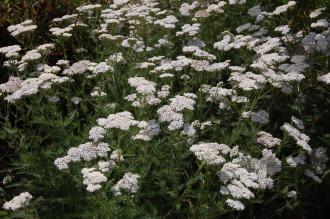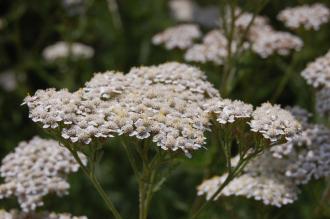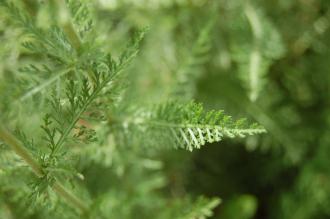
Achillea millefolium (27/07/2013, Kew Gardens, London)
Position: Full sun
Soil: Well drained soil
Flowering period: Summer
Eventual Height: 90cm
Eventual Spread: 90cm
Hardiness: 3a, 3b, 4a, 4b, 5a, 5b, 6a, 6b, 7a, 7b, 8a, 8b, 9a, 9b
Family: Asteraceae
Achillea millefolium is an evergreen herbaceous perennial with an upright habit. Its dark green leaves are fern-like and up to 20cm long. Its leaflets are pinnate with a serrate margins. Its white hermaphrodite flowers appear as a terminal cluster of up to 40 flowers as a corymbs which is up to 10cm across. Its roots are rhizomes which aids its spread.

Achillea millefolium Flower (27/07/2013, Kew Gardens, London)
Achillea millefolium, commonly known as Yarrow or Common Yarrow, is native to temperate regions of the Northern Hemisphere (including the UK). In its native habitat it grows in disturbed grasslands and open forests. This plant has a long history in traditional medicine. Given suitable conditions this plant my spread aggressively.
The etymological root of the binomial name Achillea is named after a character in Greek mythology; Achilles, the almost invulnerable warrior whose soldiers were said to use the plant to treat wounds. Millefolium is derived from the Latin millia meaning ‘ thousands’ and folium meaning ‘leaf’.
The landscape architect may find Achillea millefolium useful as part of a wild flower meadow mix. It is also appropriate for inclusion in informal prairie schemes. Its is also a suitable component of a butterfly garden. It is drought tolerant once established.
Ecologically, Achillea millefolium is very attractive to pollinating insects. Some birds use its stems to build their nests.

Achillea millefolium Leaf (27/07/2013, Kew Gardens, London)
Achillea millefolium prefers moist, fertile, well-drained soils. It tolerates most pH of soil. It will tolerate well drained poor soils.
Achillea millefolium requires little maintenance. Clumps may be cut back in spring to create a tidy appearance. Large clumps may be divided in spring.

